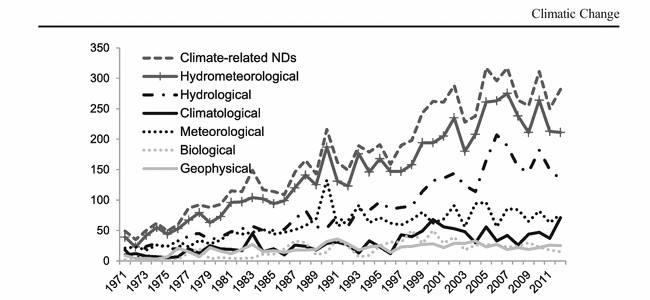
Asia and Pacific: Frequency of Natural Disaster Costantly Growing
MANILA, PHILIPPINES – A Natural Disaster is defined as an events, triggered by hazards of nature, and causing at least 100 deaths or affecting the survival needs of at least 1,000 people.
The frequency of intense natural disasters increased notably from the 1970s to the 2000s. Around half of these events happen in Asia and Pacific Area. Intense hydrometeorological disasters and climatological disasters accounted for most of the worldwide increase in natural disasters.The Springer.com Open Access Science and Media website publish a new paper about disaster prevention and climate action. This pubblication is an indipendent evalutaion at the Asian Development Bank.
INTRODUCTION TO NATURAL DISASTER
Countries in Asia and the Pacific should ramp up preventive measures to avert disasters from floods, storms, droughts and heat waves, in addition to better measures in response to these events.
“While improved reporting is sometimes credited with some of such rising frequencies, this focus on intense events reduces that possibility. Furthermore, while we note a sizable increase in the frequency of intense climate-related disasters, the frequency of intense geophysical disasters (related to earthquakes and volcanoes) has only slightly increased” Says the researcher Vinod Thomas, Jose Ramon G. Albert and Cameron Hepburn.
“Around the globe, the frequency of these events has risen notably during the past four decades, with about half hitting countries in this region, according to Contributors to the Frequency of Intense Climate Disasters in Asia-Pacific Countries. Yet natural disasters are still often treated as one-off acts of nature rather than the result of factors also influenced by human activities. Their prevention receives inadequate policy attention as a result, says the paper appearing in the journal Climatic Change”.
The paper’s authors—Vinod Thomas of Independent Evaluation at the Asian Development Bank, Jose Ramon G. Albert of the Philippine Institute for Development Studies, and Cameron Hepburn of Oxford University and the London School of Economics—identify three major risks that can turn a hazard into a disaster: the exposure of growing populations to the hazards, their greater vulnerability in dealing with them, and the increase in the frequency and intensity of climate-related hazards.
“This study gives an empirical basis to the relationship between climate anomalies and the frequency of disasters, and draws attention to the need for preventive measures, including climate mitigation,” says Vinod Thomas.
FREQUENCY OF CLIMATOLOGICAL DISASTER: WHY?
Rising greenhouse gas concentrations in the atmosphere can be linked to climate variables such as temperature and precipitation that underlie floods, storms, droughts and heat waves, albeit in differing degrees and differently across countries. The findings associate more frequent climatological disasters (relating to droughts and heat waves) with rising temperatures; and hydro-meteorological disasters (relating to floods and storms) with people locating in harm’s way and precipitation anomalies. Policymakers are aware that the atmospheric concentration of CO2, the primary greenhouse gas, recently surpassed 400 parts per million and is set to exceed 450 in a quarter century at current rates of change. The recent 5th Assessment Report of the Intergovernmental Panel on Climate Change reaffirms the human influence in the warming of the climate system, mostly through the increase in the atmospheric concentration of CO2.
Adequate responses call for two sets of policies. First, reducing the exposure of the population and its vulnerability should feature centrally in controlling the growing threat from these events. This was particularly apparent after a storm surge associated with the super Typhoon Haiyan in 2013 killed thousands in the low-lying Philippine city of Tacloban.
Governments need to build disaster resilience into national growth strategies and treat it as investment. Japan invests some 5% of gross domestic product in this area with strong results. High returns are also evident even where spending is far less. In Bangladesh, effective warning systems and evacuation centers made the difference between a powerful cyclone in 1997 with 185 lives lost in comparison with a similarly strong storm in 1970 that took some 300,000 lives.
PHILIPPINES, A GOOD EXAMPLE
In the Philippines, the Manila flood of 2012 demonstrated the benefits of social media alerts and early warning systems. Likewise, new hazard maps and an improved rain- and water-level monitoring system promoted by Project NOAH (Nationwide Operational Assessment of Hazards) have proved their worth.
Second, climate mitigation is urgently needed. This would include making the most of win-win interventions that promise simultaneous environmental and economic benefits. Foremost among these are measures for achieving far greater energy efficiency and abating sizable energy losses.
In addition, net-win policies are needed—that is, measures for green growth that incurs costs but, on balance, benefit the economy. High on the list would be investments in low-carbon technologies and renewable energy, as well as forest protection, such as adoption of carbon sequestration to capture and store emissions from industry.
“This paper’s empirical evidence, on an association between the rising frequency of intense natural disasters in Asia and the Pacific countries and climate change, stresses the urgency for reducing man-made greenhouse gases in the atmosphere,” says Thomas.


